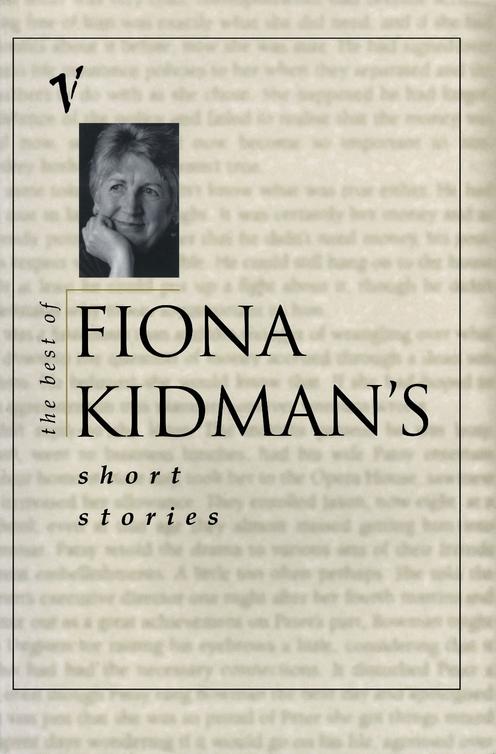Read The Best of Fiona Kidman's Short Stories Online
Authors: Fiona Kidman
The Best of Fiona Kidman's Short Stories


FIONA KIDMAN first wrote short stories in the 1960s and has continued to publish them in books, magazines and journals ever since. Her style has developed and changed, but her piercingly vivid realisation of everyday people has remained a characteristic of her work. This is a collection of the best of her storiesâsome previously uncollected, some new, others old favourites from her earlier acclaimed collections such as
Unsuitable Friends
and
The Foreign Woman.
FIONA KIDMAN was born in 1940. She has worked as a librarian, creative writing teacher, radio producer and critic, but primarily as a writer. To date, she has published 17 books, including novels, poetry, non-fiction and a play. She has been the recipient of numerous awards and fellowships, and was created a Dame (DNZM) in 1998 in recognition of her contribution to literature.
Fiona Kidman's
Short Stories


For Ian, and our family

Early Stories
From
Mrs
Dixon
and
Friend
From
Unsuitable
Friends
From
The
Foreign
Woman
New Work

S
OMETIME IN THE MID
-1960s I began to write short stories. With youthful enthusiasm and, I see, looking back, only a limited appreciation of the form, I wrote them as practice for the larger undertaking of a novel. It was not long before I began to write them in earnest, for their own sake.
In those early days, I wrote everything with the passionate abandon which now looks like the work of another person. I envy myself that period in my life. I put down whatever came to my head, never asking myself whether or not a piece of writing was appropriate â whatever appropriate meant. It was in this artless state of grace that I wrote a number of stories about rural Maori life, stemming from my early experience. They were all published in
Te
Ao
Hou.
Later, as a Pakeha, I was challenged about their validity. In 1976, at the Maori Writers' and Artists' hui at Lake Rotoiti, a group of young Pakeha told me that I was giving offence. In retrospect, I don't know whether this was true or not. None of the Maori writers with whom I associated at the time (and who remain my good friends) had thought it necessary to call me to task. All the same, I did listen, although the immediate results were not happy. I began to write from a strictly conformist Pakeha point of view, in which Maori might just as well have lived in a different country from the one that I was writing about.
Over a period of time, this dilemma was resolved. I began to see that I could not write about a society that was all about one race or another, any more than I could write specifically from a particular class. I wrote a story called âNeedles and Glass' which is about looking across from one culture to another, and the irresistible influence that we have on each other; indeed, about the inescapable longing to be part of each other. In my case, it was fact. My children combine the racial mixes of this country. But at another level, I had taken the point. I began to write in a more inclusive way, so that people
appeared, regardless of race, if they were part of the story. But I stopped writing them in the first person. I am who I am. Most of these early stories have been buried for many years. When I came to collect my stories I decided that they had their place. They belong in my development as a writer and are true to my particular vision of the world when I wrote them. Some of them are reproduced here.
The first person has got me into other difficulties. Ours is a small country, and readers see the author as persona lurking under every ant hill. Having worked in radio, I was aware of the enormous impact of the first person on readers. Rule one, if you want to present a story as fiction, don't use the first person on radio. People will always believe it is the gospel truth about yourself. But this ârule' became a tyranny in itself. In the mid 1980s I wrote âThe Whiteness', a first person story about a woman visiting Crete. This was first accepted by an editor, then rejected by his successor, on the grounds that it was âan excellent piece of travel writing but not a short story'. Of course, the editor couldn't be sure about this, because he didn't know whether or not the events in the story had taken place, or whether the narrator was actually in the state of mind which she recounts. After some to-ing and fro-ing, the story was published in
Landfall.
Once it was published I felt as if I had won a sort of freedom. I set about reclaiming the first person. It is a wonderfully free way to unblock imaginative inhibitions. The mind is at liberty to explore fantasy and wish fulfilment that a character might indulge in. The voyeurism of the character in âPudding' is a case in point. I often write a story in the first person, and then in the third. Alternating closer and further distances can reveal more and more facets of the same character. Several drafts may pass before I make a decision about which point of view best suits the ultimate story.
It was around the same period as âThe Whiteness' that I began to move away from the well-made short story. I was, by then, in thrall, and unashamedly falling under the influence of the Canadian writer, Alice Munro. In her footsteps, I turned belatedly to Chekhov. I learned that the short story could do more than just present a situation and resolve itself. Within the framework of the long short story there was room to unfold whole lives. Munro's marvellous story of truth and consequences âWhite Dump' became a touchstone. I do not want to invite unwelcome comparisons â as a writer my own voice is the one I seek to express. But when you find a writer who is developing a genre in a particular way that excites you, inevitably it leads to a new focus, a different way of examining your own method of working. It took me a little while to work out what Munro was up to; I learned from reading and re-reading her work that it is, in the main, a subversion of the
traditional âcurve' so beloved by creative writing teachers (and one that I, too, discuss in class) to demonstrate story arrival points (this is a causative action class, this is the rising action, the crisis point, this is the resolution and the denouement), into the form of a three-act play. As much of my early work had been writing for the stage, and radio drama, my fascination began to make sense. There are several curves within the framework, and room for sub-text and complications to unravel themselves within eight or ten thousand words. I have mostly been working in variations of this extended form ever since. It's an interesting challenge; with the same emotional scale as a novel there is still a spine-tingling requirement to achieve the precision of the short story. I wish there was another way to describe this form beside the long short story. It is effectively a genre in itself. Short fictions is the fashionable
terminology
but it seems inadequate to me.
There have been some exceptions and some costs to working in this way. The exceptions are a handful of short stories commissioned for radio, or encouraged by the
Listener
in its more literary days, of which âHats' was one. âHats', about a family wedding, and written one morning, reminded me that the more conventional story form has
telling
power that can communicate in a direct way with audiences. A good short story is an excellent performance vehicle for a writer. âHats' has travelled well in New Zealand and over two continents. I must have read it to live audiences a hundred times. It became my safety blanket. One day, I simply had to stop, and move on. But it is still one of my favourite stories.
The cost of writing long stories has been restricted markets. I am tremendously grateful to Robyn Langwell at
North
and
South
magazine for running some of my stories, affording them generous space and illustration, and providing a much wider audience than one would normally hope for. Otherwise, the market has had to be in book form, which means that the appearance of new stories is spasmodic.
People often ask how the decision is made to write a short story rather than a novel. I find this hard to answer. Stories come to me whole, like poems, so there never seems to be a major problem to solve. You listen to the story in your head, and it has a sort of musical intonation, something that tells you that this is its
shape.
And then you do it. I've never written a short story that turned out to be a novel, or vice versa. Perhaps I could say that stories are the breadth of an expression, and you recognise it when it presents itself. Occasionally a story will come whole in a morning, like a gift (more recently, âIf I Should Mourn' and âNobody Else'), but that's rare and wholly improbable when dealing with the long story. For each gift of the unconscious there is a great deal of work to be done elsewhere. Writing short stories remains the
purest form of creative pleasure for me. I need hardly say that good short stories are also my favourite read.
It seems odd to have compiled a collection without the inclusion of any stories about Bethany Dixon, from whence came the title of my first story collection
Mrs
Dixon
&
Friend.
Bethany has now acquired a life of her own in
The
House
Within
which effectively relates her life story. It wasn't appropriate to duplicate the stories here again. Still, it was Bethany and the urge to keep writing her story over a period of many years, which provided a major incentive to go on writing in the form. The stories always felt open-ended, as if the character went on living beyond the moment when the end of a story had been reached. Some of the stories in this book also pick up on the threads of the past. I like to think of them as organic, living creations, not closed to the future.
Over thirty years of publishing short stories I have had more editors than I can count, but some have been especially helpful. I would like to acknowledge the late Phoebe Meikle (who took my grammar in hand), and thank Joy Stevenson, Robin Dudding, Michael Harlow, David Ling, Andrew Mason, Robyn Langwell, and Fergus Dick. In recent years, the tremendous support of Harriet Allan and Anna Rogers has ensured that my stories have maintained a profile before my readers.
Fiona
Kidman
